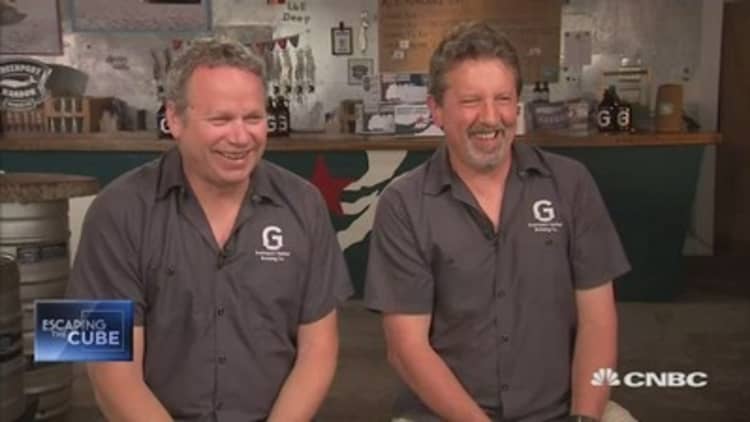Want to really disrupt the heady beer industry, which is worth more than $300 billion?
Try making a lager that beats big beer.
For years, craft brew has been nibbling away at the margins of big beer, but it's the lager part of the beer business that attracts the most customers. So in 2013, Brendan Sindell co-founded House Beer in a California garage as part of a mission to take on the Anheuser Busch-InBevs and Heinekens of the world.
"In the beginning, people said, 'You're crazy, but good luck,'" Sindell told CNBC in a recent interview.
Now, the start-up brewery has moved production to a Colorado partner and is cranking out 8,000 barrels annually. That may sound like a lot, but put in its proper perspective, beer behemoth Bud pumps out more than 120 million barrels a year.
Yet since 2010, the volume share for craft brewers in the beer market has more than doubled, according to industry data, with Americans putting a growing variety of brews to the test on their palates. Consequently, 'Big Beer's' grip on the brew market is starting to slip.
"The largest mainstream brewers have lost market share," said Chris Shepard, associate editor with industry data publication Beer Marketer's Insights. "It's been going on the last five years."
Craft beer is a force to be reckoned with at this point. It's craft brewers saying, 'Ok, we can play at this, too.'Chris Shepardassociate editor, Beer Marketer's Insights
For years, craft beer has been guzzling up more and more of the global beer market that remains dominated by large multinationals. The beer market makes up somewhere between $250 billion and $300 billion in economic activity, according to industry reports, and it is increasingly pitting smaller start-ups against enormous corporations with huge distribution advantages.
Ultimately, the consumer will have the final say—and trends suggest a growing number are shying away from traditional brands.
"We grew up drinking the mainstream domestic stuff," Sindell said. "We don't drink those now."
The lager business, according to Beer Marketer's Shephard, makes up the biggest portion of the beer industry—more than half of sales are of various lager styles, like pilsners or bocks. It means smaller beer markers, many of which produce ales, have left big beer companies to dominate that area of the market. Instead, they've opted to lure lager drinkers with stronger brews like the wildly popular India pale ale (IPA).
It wasn't until recently that craft beer accounted for more than 10 percent of the overall market. Now, as small brewers make inroads on big beer's turf and craft brewers establish their footprint, there are few remaining flavors that haven't been mashed, injected or otherwise infused into various brews.
While wacky fringe beers cater to hopped-up ale enthusiasts—with flavorings ranging from peach and raspberry to chocolate—there's also a growing push from craft brewers into traditional beers like lager and pilsner, which give them access to a broader potential customer base.
"We didn't want something too sweet; we didn't want something too hoppy," Sindell said. "Getting the product just right took some time; scaling was quite an issue."
It's not unique to House; ale brewers who rode the growing trend of more sophisticated beer into being big business (or, getting bought out by big beer) are now whipping up pilsners and lagers, breaking from the hoppy principles upon which they were founded. In recent years, popular brewers Goose Island—bought out five years ago by Anheuser-Busch—and Sierra Nevada have each debuted pilsners, lagers, or both.
But House makes one kind of beer, and that's enough.

As with any start-up, scaling is the next challenge. House is only available in Southern California and New York at the moment, but Sindell said the start-up brewery is looking into Chicago and Austin as next steps. Targeting metropolitan areas is a major part of House's strategy.
A small panel of beer experts (that is to say, CNBC and a group of seasoned beer enthusiasts whose experience spans more than six decades) tested House out and came to similar conclusions: there's none of the sour bite that accompanies a northern European lagers or pilsners. House is a lager beer that's equal parts tasty and quenching without any of the flavor drawbacks that accompany mega-lager-brewers. It's not as bitter or watered-down as some mega-brands are. And House is nothing like what the fancy ale producers make.
After years of either buying out, or using advertisements to mock their craft beer competitors, the idea that big beer may see its most valuable product line disrupted by upstart competitors should be enough to give corporate brewers bitter beer face.
"Craft beer is a force to be reckoned with at this point," Shepard said. "It's craft brewers saying, 'Ok, we can play at this, too.'"


